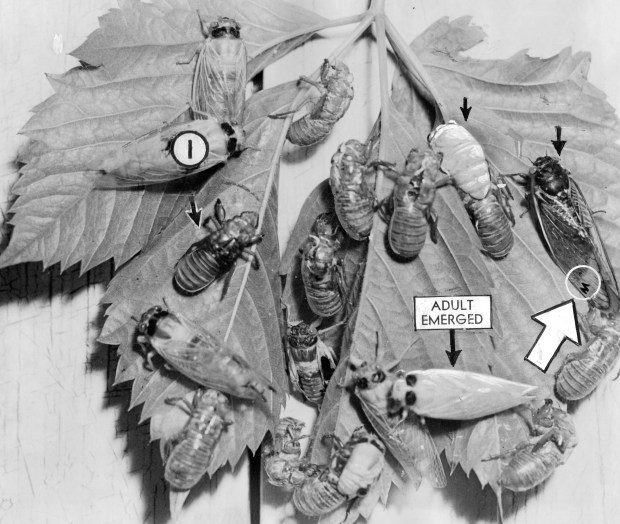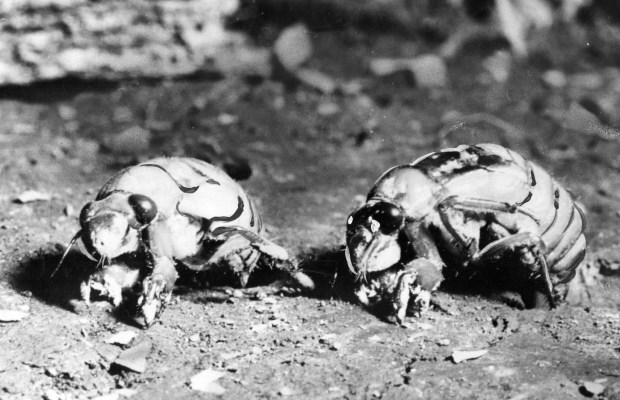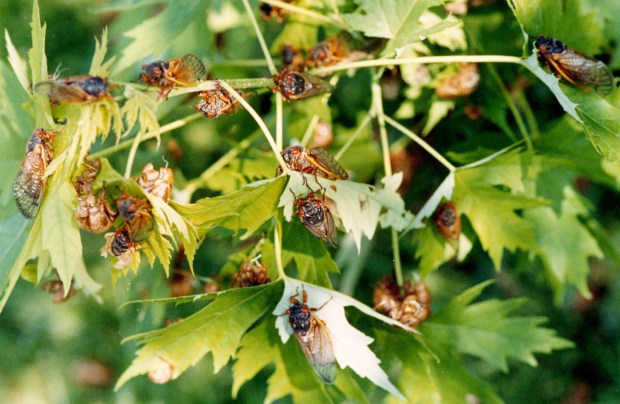It’s about to get loud.
Three species of periodical cicadas, known as Brood XIII, are expected to emerge this month from their underground habitats. The nymphs, which began as tiny eggs laid inside tree branches, have remained buried in soil nibbling on tree sap since 2007 — the same year the iPhone was introduced.
Illinois will soon be cicada central when 2 broods converge on state in historic emergence
What makes these creatures different from the cicadas that we see every summer? This brood only sees the light of day once every 17 years. And they have different features. These insects have black and brown bodies and red eyes. Our annual cicadas are green with a blue-tinted Art Deco-design on their thorax, or back.
Just as Illinois was the place to be in April to observe a rare total solar eclipse, it’s also hosting an event this summer that’s even more infrequent — one big cicada family reunion.
Brood XIX — four species that appear every 13 years in the Southeast — will also get a one-way ticket above ground this summer. It will be the first time in 221 years that these two specific broods come above ground at the same time and in such proximity. The last time this happened was in 1803 when Thomas Jefferson was president, and Illinois had yet to become a state. The broods will not necessarily overlap but emerge adjacent to each other in the Springfield and Urbana-Champaign metropolitan areas.
So, how did locals handle 17-year cicada invasions of years past? Here’s a look at what we found in the Tribune archives.
June 1922: Fighting the pests with sticks
A cicada symphony “issued loud, piercing notes” around the Fox River.
“Humming of the bugs (which the paper erroneously called “locusts”) was so pronounced that a shout could not be heard across the street,” the Tribune reported June 9, 1922.
Hundreds of people in Aurora and Joliet armed themselves with long sticks to knock the hordes of insects out of trees.
But suburbanites had no real reason to be alarmed, Tribune reporter Frank Ridgway wrote. “The cicadas do not damage field crops and the only trouble they cause is where they become abundant and injure fruit trees by egg punctures made in the twigs.
Instead, state entomologist W.P. Flint suggested cheesecloth be used to screen and protect small, valuable trees from the swarms. (Chicago Botanic Garden suggests using tulle).
May 1939: Could invasion of ‘noisy troops’ predict war?

“In earlier times, the cicada was often thought to be poisonous,” the Tribune reported as the 17-year brood began to emerge from its underground burrows. “And the small ‘W’ which appears on its wings is to many superstitious persons a warning of war.”
World War II began on Sept. 1, 1939, though the United States didn’t enter the conflict until Dec. 8, 1941 — the day after Japan attacked Pearl Harbor.
June 1956: ‘Animals can’t live on cicadas alone’

Researchers had trouble finding cicada specimens in forest preserves and relied on citizen scientists for reports of their discovery in their backyards.
Rupert Wenzel, Field Museum’s curator of insects, blamed cold weather for the brood’s belated arrival. He told the Tribune the bugs become sluggish when cold and apparently have a warming mechanism that prevents them from coming out in weather which may interfere with breeding, which is their main purpose in their short lives.
Just days later, however, their presence was felt.
“The ground is walking with them,” Forest Preserves of Cook County Superintendent Roland Eisenbeis told the Tribune.
One noticeably planted itself on the back of conductor Eugene Ormandy during Chicago Symphony Orchestra’s performance with guest soloist Marian Anderson to open Ravinia Festival’s 21st season.
A woman in Lombard observed a mockingbird mimicking the whine of a cicada.
Brookfield Zoo asked locals to round up the insects — and regretted doing so.
“We’ve got so many of them that we’ve had to put most of them in the freezer,” said Karl Plath, curator of birds. “The supply will last all of next winter. I feed them to the birds, and the zoo’s snakes, lizards, and some monkeys also consider the cicadas tasty. But animals can’t live on cicadas alone. They’re merely an added treat, like hors d’oeuvres.”
June 1973: ‘That was the month everything went sour for me’

White Sox knuckleballer Wilbur Wood posted four straight seasons with 20 or more victories (1971-1974). In the two seasons prior to 1973, Wood started an amazing 93 times and won 46 games.
The Massachusetts native began June 1973 with a 13-3 record and a 1.71 earned run average. He also made the cover of Sports Illustrated. Rain at the Indianapolis 500 forced the need for a substitute story and Wood’s was it. (The situation was known for decades by insiders at the magazine as a “Wilbur Wood.”)
But just months after he became the first White Sox pitcher to be paid in six figures for a single season, Wood’s struggles began with the emergence of the cicadas. He posted a 1-8 record in June 1973 — ending the month with six consecutive losses.
“The next time the whirring creatures descend on us in 1990, don’t blame Wood if he thinks back 17 years and remarks, ‘That was the month when everything went sour for me,’” Tribune reporter Richard Dozer wrote.
Wood’s troubles continued into July. He missed the All-Star game to be with his son Derron, who was recovering from adenoid removal surgery. Then on July 20, 1973, Wood became the first pitcher in more than a half century to lose both ends of a doubleheader to the Yankees, 12-2 and 7-0.
During June, July and August combined, Wood won 10 games and lost 17. Yet he still managed to compile a 24-20 record — leading the American League in wins and placing second in losses. Wood — who pitched a total of 359.1 innings that season — was sent home by the team to rest in mid-September after it became clear the White Sox would not make the postseason.
In his 12 seasons with the White Sox, Wood had a 163-148 record and a 3.18 ERA.
May 1990: Suburbs abuzz — and afraid

To calm fears about the pending cicada arrival, a psychiatrist at Loyola University Medical Center in Maywood recommended locals adopt a isn’t-that-interesting attitude and read about the insects in their encyclopedia.
“It’s not Hitchcock’s ‘The Birds,’” Domeena Renshaw said. “People should remember these are organisms with a brief (life span).”
April 2007: When you can’t beat them — eat them

The Tribune published a recipe for soft-shelled cicadas, courtesy of the University of Maryland.
As for the taste? A little like crickets.
Want more vintage Chicago?
- Become a Tribune subscriber: It’s just $12 for a 1-year digital subscription
- Follow us on Instagram: @vintagetribune
- And, catch me Monday mornings on WLS-AM’s “The Steve Cochran Show” for a look at “This week in Chicago history”
Thanks for reading!
Join our Chicagoland history Facebook group and follow us on Instagram for more from Chicago’s past.
Have an idea for Vintage Chicago Tribune? Share it with Ron Grossman and Marianne Mather at rgrossman@chicagotribune.com and mmather@chicagotribune.com



